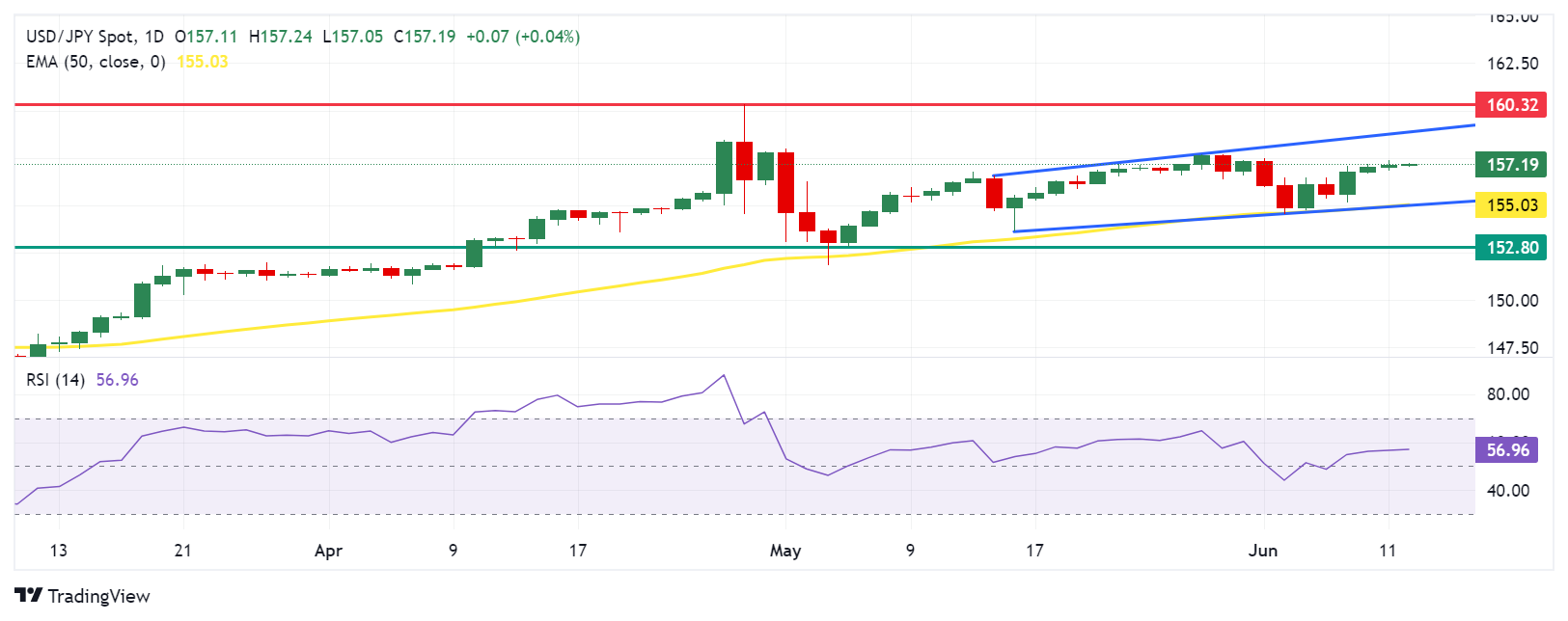- The Japanese Yen edges lower as traders favor the US Dollar ahead of the Fed's interest rate decision.
- The downside of the JPY may be limited as PPI jumped 2.4% YoY in May, exceeding market expectations of a 2.0% rise.
- The US Dollar maintains its position as robust US jobs data for May has diminished the likelihood of a Fed rate cut in September.
The Japanese Yen (JPY) continues its losing streak for the fourth consecutive session on Wednesday. The USD/JPY pair strengthens as investors favor the US Dollar (USD) ahead of the Federal Reserve's (Fed) decision and the release of US inflation figures for May, scheduled for later in the North American trading hours.
The Japanese Yen may receive support due to higher-than-expected Japanese Producer Price Index (PPI) data. Data showed that producer prices jumped 2.4% year-on-year in May, exceeding market expectations of a 2.0% rise, fueling concerns that this might lead to higher consumer inflation.
The Bank of Japan (BoJ) is expected to maintain its monetary policy unchanged on Friday. The interest rate divergence between the US and Japan continues to undermine the Japanese Yen (JPY), creating a tailwind for the USD/JPY pair.
The US Dollar Index (DXY), which measures the value of the US Dollar (USD) against six major currencies, remains strong as robust US jobs data for May has reduced the odds of a Fed rate cut in September. The CME FedWatch Tool indicates that the likelihood of a Fed rate cut in September by at least 25 basis points has decreased to 52%, down from 67% a week earlier.
Daily Digest Market Movers: Japanese Yen declines due to interest rates differential
- Japan Finance Minister Shunichi Suzuki said on Tuesday it is important to continue efforts to achieve economic growth and attain fiscal health to retain confidence in the country's fiscal policy, per Reuters.
- Nearly two-thirds of economists surveyed in a Reuters poll on Tuesday anticipate that the Bank of Japan will opt to commence tapering its monthly bond purchases at Friday's policy meeting. This decision marks a significant initial move aimed at gradually reducing the central bank's burgeoning balance sheet.
- Takeshi Minami, Chief Economist at Norinchukin Research Institute said, "There is no longer any reason to continue large-scale purchases of government bonds since it has been judged that a 2% rise in prices is within reach," per Reuters.
- Japan’s 10-year government bond yield moves below 1% ahead of the Bank of Japan’s (BoJ) policy meeting on Friday. The central bank is expected to maintain its current rate policy, while traders are closely watching for any potential reduction in the bank’s monthly bond purchases.
- On Monday, Japan’s Gross Domestic Product (GDP) Annualized contracted by 1.8% in the first quarter, compared to a previous decline of 2.0%. The figures slightly exceeded market forecasts of a 1.9% decrease. Meanwhile, Japan's GDP (QoQ) shrank by 0.5%, which is in line with the flash data.
- Rabobank suggested in its weekly report that the Federal Reserve may cut rates in September and December, more likely because of a deteriorating economy than because of progress on inflation. This is because they think that the US economy is entering a stagflationary phase with persistent inflation and an economic slowdown that is likely to end in a mild recession later this year.
- According to Reuters, while speaking to parliament last week, Bank of Japan (BoJ) Governor Kazuo Ueda stated that inflation expectations are gradually rising but have yet to reach 2%. Ueda said, "We have been scrutinizing market developments since the March decision. As we proceed to exit our massive monetary stimulus, it's appropriate to reduce bond purchases."
Technical Analysis: USD/JPY hovers around 157.00
USD/JPY trades around 157.20 on Wednesday. Analysis of the daily chart suggests a bullish inclination as the pair consolidates within an ascending channel pattern. Additionally, the 14-day Relative Strength Index (RSI) is above the 50 level, indicating a tendency for upward momentum.
A significant hurdle is noticeable at the psychological level of 158.00. A breakthrough above this level could provide support, potentially guiding the USD/JPY pair toward the upper boundary near 158.80. Further resistance is observed at 160.32, marking its highest level in over thirty years.
On the downside, the lower boundary of the ascending channel is around the 50-day Exponential Moving Average (EMA) at 155.03. A breach below this level might intensify downward pressure on the USD/JPY pair, potentially directing it toward the throwback support area around 152.80.
USD/JPY: Daily Chart
Japanese Yen price today
The table below shows the percentage change of the Japanese Yen (JPY) against listed major currencies today. Japanese Yen was the weakest against the Australian Dollar.
| USD | EUR | GBP | CAD | AUD | JPY | NZD | CHF | |
| USD | -0.04% | -0.09% | -0.07% | -0.13% | 0.11% | -0.02% | -0.10% | |
| EUR | 0.05% | -0.05% | -0.03% | -0.09% | 0.16% | 0.02% | -0.05% | |
| GBP | 0.09% | 0.05% | 0.02% | -0.04% | 0.20% | 0.05% | -0.02% | |
| CAD | 0.07% | 0.02% | -0.02% | -0.06% | 0.17% | 0.04% | -0.03% | |
| AUD | 0.13% | 0.09% | 0.04% | 0.06% | 0.24% | 0.10% | 0.03% | |
| JPY | -0.11% | -0.15% | -0.21% | -0.18% | -0.21% | -0.12% | -0.21% | |
| NZD | 0.02% | -0.02% | -0.07% | -0.04% | -0.11% | 0.14% | -0.07% | |
| CHF | 0.09% | 0.05% | 0.00% | 0.03% | -0.03% | 0.20% | 0.07% |
The heat map shows percentage changes of major currencies against each other. The base currency is picked from the left column, while the quote currency is picked from the top row. For example, if you pick the Euro from the left column and move along the horizontal line to the Japanese Yen, the percentage change displayed in the box will represent EUR (base)/JPY (quote).
Japanese Yen FAQs
The Japanese Yen (JPY) is one of the world’s most traded currencies. Its value is broadly determined by the performance of the Japanese economy, but more specifically by the Bank of Japan’s policy, the differential between Japanese and US bond yields, or risk sentiment among traders, among other factors.
One of the Bank of Japan’s mandates is currency control, so its moves are key for the Yen. The BoJ has directly intervened in currency markets sometimes, generally to lower the value of the Yen, although it refrains from doing it often due to political concerns of its main trading partners. The current BoJ ultra-loose monetary policy, based on massive stimulus to the economy, has caused the Yen to depreciate against its main currency peers. This process has exacerbated more recently due to an increasing policy divergence between the Bank of Japan and other main central banks, which have opted to increase interest rates sharply to fight decades-high levels of inflation.
The BoJ’s stance of sticking to ultra-loose monetary policy has led to a widening policy divergence with other central banks, particularly with the US Federal Reserve. This supports a widening of the differential between the 10-year US and Japanese bonds, which favors the US Dollar against the Japanese Yen.
The Japanese Yen is often seen as a safe-haven investment. This means that in times of market stress, investors are more likely to put their money in the Japanese currency due to its supposed reliability and stability. Turbulent times are likely to strengthen the Yen’s value against other currencies seen as more risky to invest in.
Information on these pages contains forward-looking statements that involve risks and uncertainties. Markets and instruments profiled on this page are for informational purposes only and should not in any way come across as a recommendation to buy or sell in these assets. You should do your own thorough research before making any investment decisions. FXStreet does not in any way guarantee that this information is free from mistakes, errors, or material misstatements. It also does not guarantee that this information is of a timely nature. Investing in Open Markets involves a great deal of risk, including the loss of all or a portion of your investment, as well as emotional distress. All risks, losses and costs associated with investing, including total loss of principal, are your responsibility. The views and opinions expressed in this article are those of the authors and do not necessarily reflect the official policy or position of FXStreet nor its advertisers. The author will not be held responsible for information that is found at the end of links posted on this page.
If not otherwise explicitly mentioned in the body of the article, at the time of writing, the author has no position in any stock mentioned in this article and no business relationship with any company mentioned. The author has not received compensation for writing this article, other than from FXStreet.
FXStreet and the author do not provide personalized recommendations. The author makes no representations as to the accuracy, completeness, or suitability of this information. FXStreet and the author will not be liable for any errors, omissions or any losses, injuries or damages arising from this information and its display or use. Errors and omissions excepted.
The author and FXStreet are not registered investment advisors and nothing in this article is intended to be investment advice.
Recommended content
Editors’ Picks

EUR/USD weakens below 1.0900 amid trade war fears
EUR/USD loses ground to trade below 1.0880 in early Europe on Thursday. Escalating US-EU trade tensions weigh on risk sentiment and the pair, lending some support to the US Dollar amid US inflation cooldown. Focus shifts to ECB-speak and US PPI data.

Gold price sticks to gains near all-time high ahead of US PPI; bulls shrug off modest USD strength
Gold price retains its positive bias through the first half of the European session on Thursday and remains within striking distance of the record high touched on February 24. Persistent worries about the potential economic fallout from Trump's aggressive trade policies benefit the safe-haven bullion for the third successive day.

GBP/USD stay defensive near 1.2950 as risk-off mood persists
GBP/USD is on the defensive near 1.2950 in the European session on Thursday. The pair faces headwinds from intensifying tariff war globally and a pause in the US Dollar downtrend. Traders look forward to the US PPI data for fresh directional impetus.

Metaverse narrative stalls as price action fades, but on-chain data signals continuing accumulation
Metaverse tokens are cryptocurrencies associated with virtual worlds, digital economies, and immersive online experiences. Tokens like Sandbox (SAND), Decentraland (MANA), and Axie Infinity (AXS), three of the most prominent assets during the Metaverse boom of 2021, continue to face correction since they topped in early December.

Brexit revisited: Why closer UK-EU ties won’t lessen Britain’s squeezed public finances
The UK government desperately needs higher economic growth as it grapples with spending cuts and potential tax rises later this year. A reset of UK-EU economic ties would help, and sweeping changes are becoming more likely.

The Best brokers to trade EUR/USD
SPONSORED Discover the top brokers for trading EUR/USD in 2025. Our list features brokers with competitive spreads, fast execution, and powerful platforms. Whether you're a beginner or an expert, find the right partner to navigate the dynamic Forex market.
